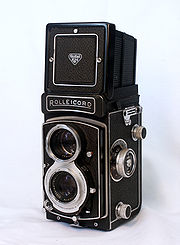
Rolleicord
Encyclopedia

The Rolleicord was a popular medium-format twin lens reflex camera
Camera
A camera is a device that records and stores images. These images may be still photographs or moving images such as videos or movies. The term camera comes from the camera obscura , an early mechanism for projecting images...
made by Franke & Heidecke (Rollei
Rollei
Rollei is a German manufacturer of optical goods founded in 1920 by Paul Franke and Reinhold Heidecke in Braunschweig, Lower Saxony, and maker of the Rolleiflex and Rolleicord series of cameras...
) between 1933 and 1976. It was a simpler, less expensive version of the high-end Rolleiflex
Rolleiflex
Rolleiflex is the name of a long-running and diverse line of high-end cameras originally made by the German company Franke & Heidecke, and later Rollei-Werk. The "Rolleiflex" name is most commonly used to refer to Rollei's premier line of medium format twin lens reflex cameras...
TLR, aimed at amateur photographers who wanted a high-quality camera but could not afford the expensive Rolleiflex. Several models of Rolleicord were made; the later models generally had more advanced features and tend to be valued higher in today's market.
The first Rolleicord, introduced in November 1933, was the Rolleicord I. This camera was a simplified version of the Standard Rolleiflex, with a cheaper 75mm Zeiss Triotar lens
Photographic lens
A camera lens is an optical lens or assembly of lenses used in conjunction with a camera body and mechanism to make images of objects either on photographic film or on other media capable of storing an image chemically or electronically.While in principle a simple convex lens will suffice, in...
and a simplified film advance mechanism using a knob instead of the crank found on the Rolleiflex. The Rolleicord I was available either with a plain leatherette covering or elaborately patterned metal faceplates. The latter variant is referred to as the "Art Deco
Art Deco
Art deco , or deco, is an eclectic artistic and design style that began in Paris in the 1920s and flourished internationally throughout the 1930s, into the World War II era. The style influenced all areas of design, including architecture and interior design, industrial design, fashion and...
" Rolleicord.
The models that has the letters DRP on the left and to the right DRGM on the front of the camera means that they were made before World War II
World War II
World War II, or the Second World War , was a global conflict lasting from 1939 to 1945, involving most of the world's nations—including all of the great powers—eventually forming two opposing military alliances: the Allies and the Axis...
, because DRP means 'Deutsches Reichs Patent' (German Reich Patent) and DRGM means 'Deutsches Reichs Geschmacks Muster' (basically a copyright for the name). In post WW2 models you will find DBP and DBGM. They switched from Reich to Bund (German Federal Patent).
Later models incorporated improved designs for the taking lens, including the Carl Zeiss
Carl Zeiss
Carl Zeiss was a German maker of optical instruments commonly known for the company he founded, Carl Zeiss Jena . Zeiss made contributions to lens manufacturing that have aided the modern production of lenses...
Tessar
Tessar
The Tessar is a famous photographic lens design conceived by physicist Paul Rudolph in 1902 while he worked at the Zeiss optical company and patented by Zeiss; the lens type is usually known as the Zeiss Tessar....
and Schneider Kreuznach Xenar, both of which appeared on the Rolleiflex. However, while the Rolleiflex was available with an f/2.8 lens, the Rolleicord was never offered with a larger aperture than f/3.5, thus ensuring its pedigree as an "amateur" camera.
An accessory, known as a Rolleikin kit, was available for the Rolleicord to enable it to accept 35mm film.
List of models

- Rolleicord I (Art Deco) (1933-1936)
- Rolleicord I (leatherette) (1934-1936)
- Rolleicord Ia (1936-1947)
- Rolleicord II (1936-1937)
- Rolleicord II, type 2 (1937-1938)
- Rolleicord II, type 3 (1938-1939)
- Rolleicord II, type 4 (1939-1949)
- Rolleicord II, type 5 (1947-1950)
- Rolleicord II, type 6 (1949-1950)
- Rolleicord III (1950-1953)
- Rolleicord IV (1953-1954)
- Rolleicord V (1954-1957)
- Rolleicord Va (1957-1961)
- Rolleicord Vb (1962-1976)

